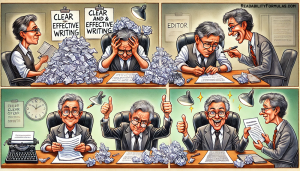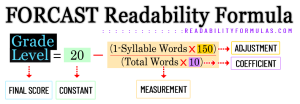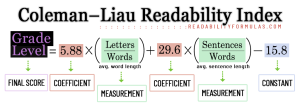Writers can score their text with a readability formula to find out beforehand if their readers can read their text with little or no trouble. On average, general public readers can comprehend most texts at a high school level (between 7-8th grade). This is one reason why writers should aim for an average or below-average readability level. A readability formula can help during the editing process, but writers shouldn’t solely rely on it.
A person’s ability to read is based not only by their reading skill, but also by their interest to read. Even good readers may decide not to read important information if they lack interest to do so. An article in the The Journal of Educational Studies (2018) revealed that a reader’s desire to read greatly impacts understanding.
Similarly, low-level readers may struggle to understand difficult material, even if they are interested in the topic. Just as writers can choose different words and sentence lengths to affect readability, they also can affect a reader’s motivation. Readable writing is more than writing simply and concisely. Your writing has to entertain and engage one’s interest.
Of course, simplifying your writing to achieve a specific reading level is not the best strategy. For example, if you write for professionals or trades people who understand technical information, then you probably don’t want to remove familiar hard words or “industry jargon,” otherwise these skilled readers (your peers) will find your writing style flat and dull.
Improve Readability This Way
The following advice will help you write for your readers. These techniques follow the rules of plain English writing.
TIP #1: Use one and two syllable words if appropriate. Readers at all reading levels can recognize high-frequency words (sometimes called “basic sight words“), such as — ‘he, ‘her,’ ‘them,’ ‘there,’ ‘is,’ ‘and,’ ‘some,’ ‘same,’ ‘we,’ ‘you,’ ‘tree.’ Avoid using too many 3+ syllable words, unless that word is familiar to your readers.
TIP #2: When possible, write short, simple sentences. Introduce one idea in a sentence. Restrict the number of new ideas on a page. State the main idea at the beginning of each paragraph so the reader immediately knows the idea.
TIP #3: Use connective words (‘firstly,’ ‘initially,’ ‘lastly,’ ‘however,’ ‘therefore,’ etc.) to help guide readers through sentences and paragraphs.
TIP #4: Use active voice. Too many instances of passive voice will trouble poor readers and make sentences longer. Active voice makes your writing style and voice concise and succinct. William Knowlton Zinsser, the esteemed American writer, once said, “Verbs are the most important of all your tools. They push the sentence forward and give it momentum. Active verbs push hard; passive verbs tug fitfully.”
TIP #5: Define difficult words by context clues, such as using parentheses to elaborate on a word, or using a footnote or citation to explain the word.
Example:
Parenthetical Elaboration: “The little boy showed his bravery (courage in the face of danger) when he stood up to the bully.”
Using a Footnote: “She had an idyllic* childhood, surrounded by loving family and picturesque landscapes.”
*Idyllic: extremely happy, peaceful, or picturesque.
TIP #6: Summarize important points in short paragraphs, perhaps with subheadings to break up bulky paragraphs. This helps readers skim the text or refer back to a specific paragraph.
TIP #7: Illustrations, speech bubbles, bullets, photos, graphs and different typefaces can add appeal to your text and retain your readers’ interest.
TIP #8: Readers like “lists”—they can easily read sequential information or a series of events or ideas in narrative form. Good writers lead readers from point A to point B to point C and so on; they don’t skip around or zig-zag around multiple ideas. Readers will quickly lose interest if you make them jump around to make sense of things.
TIP #9: Choose a writing style that is easy to follow. Two popular writing styles include: 1) the “‘question-answer” style in which the writer asks a question and then answers it in detail; and 2) the “sharing-experience” style in which the writer describes an experience in personal terms. You can also use the “list” style (as mentioned above) to emphasize main ideas in order.
TIP #10: Nobody enjoys squinting and brainstorming through a long page of unfamiliar narrative. Font size and style affect both readability and reader retention. Similarly, the type and finish of paper influence the reader. Select typeface, colors, and layout sizes that attract readers and work in harmony with the purpose and tone of your message.
TIP #11: Add greater interest to your writing by using personal words, pronouns, names of people, etc. You can further connect with your readers by using personal sentences, such as quoted dialogue, spoken sentences, questions, commands, requests, exclamations, etc.
TIP #12: Use a short slogan to convey information in a memorable way. “Take a break between exercises” is more effective than, “During a series of long exercises, take a 15 minute break to slow down your heart rate.” The former statement also uses “basic sight words” and can be read by anyone with a primary-grade reading level.
TIP #13: Break up long stretches of narrative passages with bold or italicized subtitles and/or captions. Captions and subtitles allow the reader to comprehend major points and digest your material more easily.
TIP #14: Highlight important ideas and terms with boldface type, italics or sentence indentions.
TIP #15: Fall in love with white space. Plenty of white space around black text is inviting. Crowding a page with blocks of text can confuse low-level readers.
TIP #16: Make technical terms look more easy to read. You can add a phonetic pronunciation or a similar-sounding word in parentheses to help readers decode the word.
Example:
Phonetic Pronunciation: “The biologist discussed the animal’s biorhythms (bio-ry-thms) during the seminar.”
Similar-Sounding Word: “He studied the phenomenon (feh-NO-muh-non, think ‘phenomenal’ without ‘al’) of northern lights.”
Motivate Your Readers This Way
Motivating your readers is another part of effective writing. If you can’t motivate your readers or pique their interests, they’ll go elsewhere.
TIP #1: Know who your readers are, what they need, and what challenges they face. Tailor your content to meet those needs. Example: If writing for electricians, discuss common on-site challenges and code updates. Relate to their daily work life, including their struggles.
TIP #2: Begin with clear objectives. Let your readers know what they will gain by reading your article. Example: Start by stating, “By the end of this article, you’ll know how to navigate the latest tax laws affecting your trade business.”
TIP #3: Everyone loves a good story. Weave your points into a narrative that readers can follow. Example: Share a success story of a well-known professional who improved their business by following the advice you’re about to give.
TIP #4: Make it clear why your content matters. Connect your writing to real-world issues or problems that your readers care about. Example: Link your tips to increasing profits, such as “Implementing this safety checklist can reduce accidents and save on insurance costs.”
TIP #5: Ask questions or propose challenges to involve readers. Encourage comments or ask to share experiences. Example: Invite readers to submit their own tips or stories, which you might feature in a future article.
TIP #6: Images, infographics, and videos can make content more engaging and easier to understand. Example: Include before-and-after photos of a job site to illustrate the impact of good organization.
TIP #7: Light humor can make reading more enjoyable and memorable. Example: Use a light-hearted cartoon or joke related to the trade profession to illustrate a point without undermining the article’s professionalism.
TIP #8: Sometimes offering a tangible benefit, such as a downloadable resource or a chance to win something, can motivate readers. Example: Offer a free ebook on “101 Trade Secrets” for signing up for a newsletter.
TIP #9: Use headlines and subheadings that pique curiosity and compel readers to delve into the content. Example: Use headlines like “The Surprising Tool That Can Save You Hours Each Week” to draw readers in.
TIP #10: Write in a way that shows you understand. Share your readers’ feelings or experiences. Example: Acknowledge how frustrating new regulations can be and offer solutions.
TIP #11: Use interactive elements like quizzes or polls to improve the reading experience. Example: Embed a calculator for estimating job costs or materials that the reader might need.
TIP #12: Authenticity fosters trust. Be genuine in your writing and share personal insights or stories. Example: Share a personal anecdote about a lesson learned from a job that went wrong and how it improved your practice.
TIP #13: Guide your readers on what to do next with clear, compelling calls to action. Example: after discussing a new technique, encourage readers with “Use this technique today and notice the immediate improvement in your workflow.”
TIP #14: Emphasize the most important points so they stand out and readers remember them. Example: Use a bold-face “Key Takeaway” box to summarize the main point of each section.
TIP #15: Make your content easy on the eyes with short paragraphs, bullet points, and plenty of white space. Example: Format sections with bullet points, like a list of “Top 5 Safety Practices,” for easy scanning.
Engage Your Readers This Way
You can use sensory details to engage readers more deeply—even emotionally—by appealing to the five senses (sight, sound, smell, taste, and touch). Sensory details are descriptive words that evoke mental images and sensations for the reader—they transport readers directly into the scene. How much sensory details to include depends on what you’re writing and who your readers are.
TIP #1: Instead of stating facts or telling readers how a character feels, show it through sensory details. Example: instead of saying “the cake was delicious,” describe the taste, texture, and smell of the cake to convey its deliciousness.
TIP #2: Use descriptive language, like adjectives and adverbs, that relate to the senses. Phrases like “the rough texture of the bark,” “the symphony of city sounds,” or “the aroma of roasted coffee” stimulate readers’ senses.
In a technical manual, use sensory language to help users understand the operational context or to ensure safety.
For example:
“Before starting the calibration, you should hear a soft click from the device, signaling that components are properly engaged. As you toggle the switch, you’ll feel a firm resistance—this is by design to prevent accidental activations. During operation, the machine will emit a low hum; any deviation from this sound, such as a grinding or whistling, indicates a need for maintenance. The surface of the equipment should remain cool to the touch; excessive heat warrants a safety inspection.”
In this example, auditory and tactile descriptions not only instruct but also use sensory details to guide the user through using and monitoring the equipment.
TIP #3: Comparisons can help readers connect new sensory experiences with familiar ones. Saying “the sun’s rays caressed my skin like warm honey” uses the sense of touch and taste to describe a sensation.
TIP #4: Long, flowing sentences can create a sense of languor or relaxation; short, choppy sentences can convey sharp, quick sensations.
TIP #5: Encourage readers to actively engage with the text by asking questions or suggesting they imagine sensations, e.g., “Imagine the chill of the mountain air on your skin.”
TIP #6: Sensory details can brighten a scene. For instance, describing the roughness of a character’s hands against the softness of silk adds depth to the touch sensation.
TIP #7: A narrative’s pace can affect how readers perceive sensory details. Slow pacing allows for more elaborate sensory descriptions, while fast pacing might focus on rapid, intense sensations.
TIP #8: Focus on a few strong sensory details rather than overwhelming the reader with too many sensations at once. This helps to anchor the reader in the scene without distraction.
TIP #9: Some sensory details may have cultural or emotional impact which you can leverage to connect more deeply with readers.
TIP #10: Sensory details should be relevant to the narrative and develop the setting, plot, and characters.
TIP #11: Create immersive experiences by combining multiple senses in a single description. Let readers feel like they are truly in the story.
TIP #12: Leave some details to the reader’s imagination. Let them engage their own senses so the reading experience is more personal and memorable.
Use these techniques to engage and motivate readers to read your text from start to finish.
###
Scott, Brian. “How to Improve the Readability of Anything You Write.” ReadabilityFormulas.com, 30 Nov. 2024, https://readabilityformulas.com/how-to-improve-the-readability-of-anything-you-write/.









